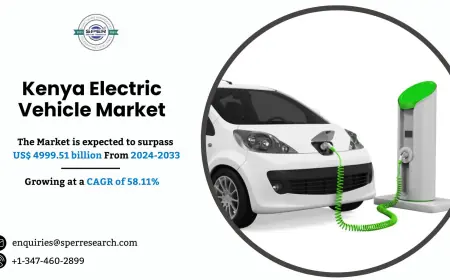Emergency Notification System in Automobile Market 2029: Growth Report with Size, Segmentation & Opportunities
Introduction
The Global Emergency Notification System (ENS) in Automobile Market has firmly established itself as a cornerstone in the modern mobility ecosystem. According to a TechSci Research investigation titled “Emergency Notification System in Automobile Market – Global Industry Size, Share, Trends, Competition Forecast & Opportunities, 2029F,” the market was valued at USD 2.08 billion in 2023, and expectations point to a compound annual growth rate (CAGR) of 6.19% through 2029. This upward trajectory is not just about expanding revenue—it’s about reshaping vehicle safety, regulatory compliance, and consumer preferences around the world.
Request For Sample Copy of Report For More Detailed Market insight: https://www.techsciresearch.com/sample-report.aspx?cid=21951#requestform
Industry Key Highlights
-
Market Size & Forecast
-
Segmentation by Key Variables
-
Components: Hardware vs. Software
-
Sales Channels: OEM integration vs. Aftermarket adoption
-
Vehicle Types:
-
Passenger Vehicles (Sedan, Hatchback, SUV, Crossover, Luxury)
-
Commercial Vehicles (Light, Medium, Heavy)
-
Government Vehicles
-
-
Applications: Medical Support, Emergency Communication, Disaster Recovery, Others
-
-
Leading Application: Medical Support
-
Medical support solutions led in 2023.
-
Features such as automatic crash alerts accelerate emergency response—often the difference between life and death.
-
-
Regional Dynamics
-
The market is segmented regionally, with growth notable across North America, Europe, Asia-Pacific, Latin America, Middle East, and Africa.
-
Regulatory mandates and smart vehicle adoption rates vary across these geographies.
-
-
Market Players
-
Prominent companies making an impact include:
-
OnStar Corporation
-
Ford Motor Company
-
Robert Bosch GmbH
-
Valeo
-
Honeywell International Inc.
-
Others through strategic partnerships, M&A, and innovation.
-
-
-
Report Scope
-
Comprehensive coverage: market sizing, structure, competitive landscape, emerging trends, challenges, future outlook, and investment viability extending through 2029.
-
Browse over XX Market data Figures spread through XX Pages and an in-depth TOC on "Global Emergency Notification System in Automobile Market.” @https://www.techsciresearch.com/report/emergency-notification-system-in-automobile-market/21951.html
Emerging Trends
The ENS market is not static—it is evolving, fueled by technology convergence and shifting mobility dynamics. Here are some of the most prominent trends:
1. Integration with Telematics & Advanced Connectivity
Connected cars are the new standard. ENS platforms are increasingly woven into sophisticated telematics systems—yielding real-time crash surveillance, GPS-enhanced location tracking, and seamless data streaming to emergency response centers.
2. Shift Toward Over-The-Air (OTA) System Architecture
OTA capability allows automotive manufacturers and ENS providers to deliver updates to system software and configurations remotely. This fosters:
-
Improvements in crash detection accuracy
-
Server-side logic enhancements
-
Dynamic feature releases
3. Adoption of AI & ML for Incident Analysis
Artificial intelligence and machine learning enable ENS modules to distinguish between real crashes and false indicators (e.g., potholes or jarring road conditions). This predictive intelligence sharpens response accuracy and minimizes unnecessary dispatches.
4. Partnerships with Smart City Initiatives
Many governments are collaborating with automakers to tie ENS platforms into emergency service ecosystems within smart cities—routing notifications directly to the nearest ambulance dispatch units, traffic management, and even disaster-relief hubs.
5. Focus on Data Security & Privacy
As ENS systems collect sensitive location and driver data, encryption and compliance protocols (e.g., GDPR, CCPA) are shaping design philosophies. Future developments will emphasize anonymized data-sharing and user-controlled privacy settings.
6. Expansion Beyond Crash Alerts
Plan extensions are emerging—such as natural disaster notifications, real-time traveler advisories, third-party drop-in buttons within ride-hailing apps, and remote vehicle unlocks for stranded users.
7. Customizable Emergency Response Ecosystems
INSURTECH firms and OEMs are working to offer tiered ENS services—ranging from government-only dispatch to premium concierge-level medical coordination and remote triage.
8. Emergence in Commercial & Fleet Management
Companies operating large fleets (e.g., logistics and public transportation) are deploying ENS systems to reduce response time, enhance operational safety, and collect crash analytics at scale.
9. Regulatory Push Toward Standardization
Efforts akin to the e‑Call initiative in Europe are underway globally. A movement toward harmonized ENS standards is limiting fragmentation, reducing compatibility issues, and fostering economies of scale.
10. Affordability Trend
Technological advancements and scale are driving down hardware costs. As such, ENS solutions once reserved for luxury vehicle segments are making their way into mid-range models, accelerating mass-market adoption.
Key Market Drivers
1. Regulatory Pressures & Mandates
Regulatory agencies are raising the bar on vehicle safety. Mandates akin to the European e‑Call system—which automatically alerts emergency services during severe crashes—are expanding to new markets. Governments worldwide are requiring built-in ENS modules across new vehicle registrations.
2. Consumer Demand for Connected Safety
Today’s consumers are safety-conscious and tech-savvy. Features such as automatic crash notifications increase perceived value, make insurance premiums more attractive, and influence purchase decisions in favor of connected vehicles.
3. OEM Strategic Advantages
Automakers are using ENS as part of broader connected car platforms—offering subscription-based safety services that boost recurring revenue and deepen customer loyalty.
4. Technological Discoveries & Innovation
Improvements in sensors (accelerometers, gyros), reliability of cellular communication, and edge computing have laid the groundwork for more responsive and accurate ENS solutions.
5. Insurance Industry Incentives
Insurers often offer premium reductions for vehicles equipped with ENS systems—since these systems reduce emergency response times and lower the risk of catastrophic injury and liability settlements.
6. Increasing Accident Rates & Road Safety Needs
High rates of road fatalities continue to plague many nations. ENS systems answer a global need to reduce time-to-medical-intervention and save lives.
7. Global Adoption of Connected Infrastructure
Smart roadside units, 5G networks, and vehicle-to-everything (V2X) communication are enabling ENS platforms to operate more reliably, particularly in remote or underconnected regions.
Competitive Analysis
A vivid picture emerges when we examine the key players vying for dominance in the ENS landscape. Each brings unique strengths, strategies, and partnerships to the fore.
OnStar Corporation
-
A trailblazer in telematics, known for its OEM partnership with General Motors since the mid-90s.
-
Delivers 24/7 remote assistance, automatic crash response, and turn-by-turn navigation.
-
Bundles ENS with cybersecurity and stolen vehicle assistance.
Ford Motor Company
-
Integrates FordPass Connect featuring SOS call interventions.
-
Syncs with its roadside assistance network and connects to local emergency services in multiple regions.
Robert Bosch GmbH
-
A global supplier of hardware and embedded software.
-
Offers modular ENS components, including ESR+ radar and crash sensors.
-
Partners with OEMs, telecom operators, and software integrators for end-to-end emergency platform delivery.
Valeo
-
Provides on-board SOS systems with voice assistance, intelligent data routing, and satellite positioning through embedded connectivity modules.
-
Collaborates widely with fleet operators and automakers.
Honeywell International Inc.
-
Known for industrial safety technologies.
-
Has expanded into telematics with cloud-native emergency response platforms that integrate nautical, roadway, and airborne usage.
Johnson Controls
-
Merged vehicular connectivity services with its building and industrial connectivity — now offering emergency notification as part of holistic asset management solutions.
Eaton Corporation PLC
-
Focused on commercial vehicle electrification and safety.
-
Its ENS modules are tailored for buses, trucks, and industrial machines—with potential for government procurement.
Haas Automation Inc. & Singlewire Software LLC
-
Primarily targeting light commercial, emergency-fleet, or public-service sectors with integrated hardware-software stacks.
Regroup Mass Notification
-
Known for group alerts, adding ENS functionality to its emergency broadcast platform—particularly for specialty vehicles and industrial fleets.
Competitive Insights
-
OEM vs. Aftermarket: OEM-integrated ENS offers seamless deployment and higher margins, while aftermarket solutions reach mid-range and older vehicles.
-
Hardware + SaaS Model: Many players now combine sensors with subscription services for location, voice, medical dispatch, and data analytics.
-
Partnerships: Collaborations between hardware OEMs, telecom carriers, insurers, and EMS providers offer integrated end-user experiences.
-
Innovation Pace: Firms leveraging AI-driven incident evaluation, OTA updates, and advanced wireless architectures (e.g., 5G, NB‑IoT) are gaining differentiation.
Future Outlook
The next five years promise a dynamic landscape for ENS in automobiles. Here's what to expect:
Regulatory Convergence
Expect broader international agreements on ENS standards—harmonizing technical specs across nations, lowering barriers, and driving volume.
OTT & Embedded Connectivity
5G and NB‑IoT rollouts will enable vehicles to maintain always-on connectivity—even in remote zones—enhancing ENS reliability.
Transition to Predictive Safety Systems
Future ENS designs will tap AI to detect near‑miss scenarios, monitor driver behavior, and deliver proactive alerts—shifting systems from reactive to preventive modes.
Advanced Insurance Integration
Insurers will become more data-driven—using ENS telemetry to assess risk, modulate rates, and respond to incident events directly.
Electrified & Autonomous Vehicles
As EVs and autonomous vehicles gain dominance, ENS solutions will evolve to handle unique incidents such as battery-management events, software malfunctions, and remote fault diagnosis.
Fleet Senate Adoption
Public transport, delivery services, and ride-share platforms will lean into ENS to cut liability, respond to incidents, and improve operational transparency.
Affordable Tiered System on Bicycles & Two-Wheelers
Micro-mobility platforms will begin offering scaled-down ENS features—such as crash detection and emergency alerts—to serve millions of two-wheeler users in emerging markets.
Customers can also request for 10% free customization on this report.
Data Monetization & Analytics
OEMs may offer crash data and geolocation intelligence as anonymized feeds to insurers, municipalities, and telcos—turning ENS into a data service.
Security & Privacy as Differentiators
Brands that emphasize strong data protection or anonymized frameworks will win consumer trust and may command higher price points.
10 Benefits of This Research Report
-
Holistic Market Insights
-
Provides comprehensive analysis across components, segments, geographic regions, and application types.
-
-
Quantitative Forecasting
-
Clear projections (2023–2029) for CAGR, revenue, market share, and projected growth patterns.
-
-
Strategic Competitive Intelligence
-
Comparative profiles of key players, partnerships, M&A, and technology portfolios offer insight into industry positioning.
-
-
Identification of Growth Triggers
-
Focuses on feedback loops—regulatory shifts, consumer trends, and aftermarket needs—to guide future investments.
-
-
Emerging Trend Spotting
-
Captures trajectories in AI, telematics, and smart-city synergistic deployments before they become mainstream.
-
-
Breakpoint Analysis by Vehicle Type
-
Segments the impact across passenger cars, commercial fleets, and government vehicles—critical for targeted strategy.
-
-
Real-World Implementation Use Cases
-
Practical examples (e.g., e‑Call in Europe) serve as benchmarks for potential rollouts in other regions.
-
-
Scoring Market Risk & Opportunity
-
A structured assessment of regulation, competition, consumer behavior, and technical barriers provides risk-ready decision frameworks.
-
-
Budget & Investment Guidance
-
Financial metrics and ROI projections help companies align capital expenditure with expected market returns.
-
-
Customizable Intelligence
-
Firms can request targeted modules (e.g., by region or component type), tailored to their specific strategic direction.
-
- Contact US:
Techsci Research LLC
420 Lexington Avenue, Suite 300,
New York, United States- 10170
Tel: +13322586602
What's Your Reaction?
 Like
0
Like
0
 Dislike
0
Dislike
0
 Love
0
Love
0
 Funny
0
Funny
0
 Angry
0
Angry
0
 Sad
0
Sad
0
 Wow
0
Wow
0



















































